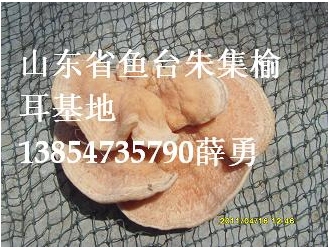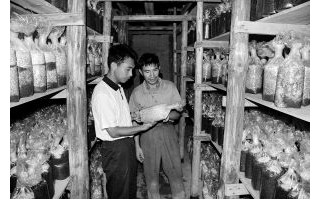抗冷冻蛋白基因遗传转化草菇的研究
Transformation of Volvariella volvacea with a thermal hysteresis protein gene by particle bombardment
郭丽琼 林俊芳 熊盛 陈守才
摘 要:采用RT-PCR技术从瑞典的北极云杉卷叶蛾幼虫中扩增出抗冷冻蛋白基因,利用基因枪法遗传转化草菇.PCR检测和Southem杂交结果证明,抗冷冻蛋白基因已整合进草菇基因组.低温胁迫试验结果表明,转基因草菇具有较强的耐低温能力.转基因草菇生物学特性观测结果显示,大多数草菇转化子的生长速率明显地慢于对照的宿主菌株,多数转化子的菌丝也明显地比宿主菌丝细弱.转化子筛选结果表明,采用三轮的转化子筛选程序,即第一轮在固体培养基上筛选、第二轮和第三轮在液体培养基中筛选,有利于获得真实转化子和淘汰假转化子.转基因草菇一代低温胁迫结果证明,转基因草菇后代仍然具有较强的低温耐受能力,这说明转基因草菇的耐低温性能在世代之间是稳定的.
关键词:草菇,抗冷冻蛋白基因,转化,基因枪法
分类号:S66.13,Q939.96 文献标识码:A
文章编号:0001-6209(2005)01-0039-05
基金项目:国家自然科学基金(39960050,30060054,30371000);广东省自然科学基金(032239);华南农业大学校长基金(5100-K03003)
作者简介:郭丽琼(1963-),女,福州市人,副研究员,博士,主要从事大型真菌分子生物学和生物技术研究.E-mail:guolq@scau.edu.cn.林俊芳,通讯作者.Tel:86-20-38902762;Fax:86-20-85280270;E-mail:linjf@scau.edu.cn
作者单位:郭丽琼(华南农业大学食品学院,生物工程系,广州,510640;中国热带农业科学院,热带作物生物技术国家重点实验室,海口,571101)
林俊芳(华南农业大学食品学院,生物工程系,广州,510640;中国热带农业科学院,热带作物生物技术国家重点实验室,海口,571101)
熊盛(中国热带农业科学院,热带作物生物技术国家重点实验室,海口,571101)
陈守才(中国热带农业科学院,热带作物生物技术国家重点实验室,海口,571101)
参考文献:
[1]Chang S T. The Biology and Cultivation of Edible Fungi. New York: Academic Press, 1978, 573- 605.
[2]谢宝贵,黄志龙,江玉姬.草菇杂交研究初报.食用菌学报,1997,4(2):5-10.
[3]Barrett J. Thermal hysteresis proteins. The International Journal of Biochemistry & Cell Biology, 2001, 33:105- 117.
[4]Raeder U, Broda P. Rapid preparation of DNA from filamentous fungi. Letter of Applied Microbiology, 1985, 1:17 - 20.
[5]Sambrook J,Fritsch E F,Maniatis T.分子克隆实验指南.金冬雁,黎孟枫,等译.第二版.北京:科学出版社,1992.
[6]Jia J H, Buswell J A, Peberdy J F. Transformation of the edible fungi, Pleurotus ostrentus and Volvariella volvacea. Mycological Research, 1998, 102(7) :876 - 880.
[7]Rhee M D V D, Graca P M A, Huizing H J, et al. Transformation of the cultivated mushroom, Agaricus bisporus, to hygromycin B resistance. Molecular and General Genetics, 1996, 250:252- 258.
[8]Sato T, Yaegashi K, Ishii S, et al. Transformation of the edible basidiomycete Lentinus edodes by restriction enzyme-mediated integration of plasmid DNA. Bioscience Biotechnology and Biochemistry, 1998, 62(12) :2346 - 2350.
[9]Virgin J B, Bailey J P. The M26 hotspot of Schizosaccharomyces pomb stimulates meiotic ectopic recombination and chromosomal rearrangements. Genetics, 1998, 149(3): 1191 - 1204.
[10]Cormack B P, Falkow S. Efficient homologous and illegitimate recombination in the opportunistic yeast pathogen Candida glabrata.Genetics, 1999, 151(3) :979 - 987.
[11]Prudhomme M, Libante V, Claverys J P. Homologous recombination at the border: Insertion-deletions and the trapping of foreign DNA in Streptococcus pneumoniae. Proceedings of the National Academy of Sciences of USA, 2002, 99(4):2100-2105.
[12]Urawa H, Hidaka M, Ishignro S, et al. Enhanced homologous recombination caused by the non-transcribed spacer of the rDNA in Arabidopsis . Molecular Genetics and Genomics , 2001, 266(4):546- 555.
[13]Kohli A, Leech M, Vain P, et al. Transgene organization in rice engineered through direct DNA transfer supports a two-phase integration mechanism mediated by the establishment of integration hot spots. Proceedings of the National Academy of Sciences of USA,1998, 95:7203 - 7208.
[14]Holmberg N, Lilius G, Bulow L. Artificial antifreeze proteins can improve Naes tolerance when expressed in E. coli. FEBS Letters, 1994, 349(3) :354 - 358.
[15]Rubinsky B, Mattioli M, Arav A, et al. Inhibition of Ca2+ and K +currents by antifreeze proteins. The American Journal of Physiology,1992, 262:542 - 545.
微生物学报
ACTA MICROBIOLOGICA SINICA
2005 Vol.45 No.1 P.39-43







